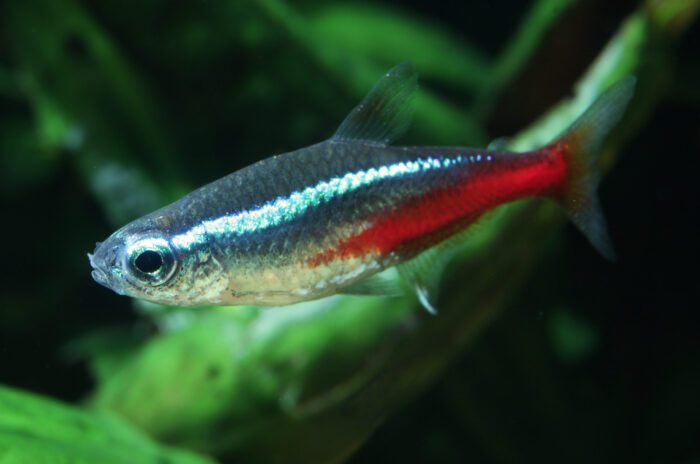Regarded as one of the most popular freshwater species making aquarium fish keeping appealing for hobby newcomers thanks to their vivid blues and reds shimmering energetically in home tanks, Neon Tetras offer perfect starter pets given moderate care needs suiting responsible children through busy adults equally if following fundamental guidelines ensuring their longevity and wellness. In this article we talk about Neon Tetra- A Complete Care Guide for Beginners.
By understanding critical bio needs around neon tank mates and ecosystem variables like filtration plus ideal feeding and preventative health practices tailored specifically to these South American beauties, both casual aquarists and passionate ichthyologists perpetuate quality environments benefiting community tanks and rare varietal breeding efforts mutually.
Table of Contents
Neon Tetra Quick Stats Overview
– Natively inhabits vegetated Amazon floodplain tributaries
– Grows up to 1.5 inches size fully mature
– Peaceful schooling fish cohabiting tanksamicably
– Thrives in pH levels 6.0-7.0 (slightly acidic)
– Requires stable water temps between 70-80 F
– Omnivorous eating both flakes and smaller live foods
Ideal Tank Setup Conditions
Given wild neon tetras occupy shallow, slow moving streams quite different from captive glass enclosures, best supporting all essential survival factors makes acclimation smoother while preventing common issues endangering species prematurely through environmental neglect.
Tank Volume – Minimum 10 gallon tanks but 15-29 gallons better suits groups 6-12 neons allowing comfortable swimming and spatial divisions avoiding aggressive flare-ups.
Substrate – Fine gravel or sand mimics natural Amazonian sediments helping beneficial bacteria colonies during nitrogen cycling managing fish waste removing toxicity. Some stemmed plants (cryptocorynes, ambulia) root within the bed too and disturb less than excavating species uprooting plants.
Filtration – External canister filtration systems offer highest water turnover rates but internal power filters also suffice partially if handling bioload under a dozen medium fish. Aim for units rated at twice total tank capacity since higher filtering capacity keeps parameters steadier.
Heating & Lighting – Submersible heaters set between 72-78F suit neon metabolism optimally. Full spectrum LED lighting prolongs neon brightness although direct sunlight works too avoiding overheating. Aim for 8-10 hour daily photoperiods.
Décor & Furnishings – Since neons school mid-level, include some smooth river rocks, driftwood branches and silk plants offering dim hideaways easing stress and breaking lines of sight between territorial competitors. Real plants aid oxygenation and beta carotenes enhancing neon coloration too.
Ideal Tank Mate Selections
Given naturally gentle dispositions maximizing harmony inside home aquariums, neon tetras integrate exceptionally with most common community species provided some considerations ensure proper size and demeanor combinations play out peacefully long term.
Top Neon Tetra Tank Mates:
– Cherry Barbs
– Large Danios
– Bronze Corydoras Catfish
– Bristlenose Plecos
– Cherry or Amano Shrimp
– Snails like Nerites
Avoid Aggressive Tankmates With Neons:
– Bettas – Attack bright colors
– African Cichlids – Larger size breeds
– Goldfish – Messier environments
– Australian Rainbows- Fin nippers
– Common Plecos – Outcompete messy
Caring For Neon Tetras: Feeding, Health & More
Offer a rotating varied diet including micro pellets, crushed flakes containing spirulina and occasional freeze dried treats like brine shrimp or daphnia preventing selective nutritional deficits or constricted digestion from cheap flakes alone. Overfeeding risks dirtying water so observe neon abdominal widths indicating hunger levels.
Perform 10-20% partial water changes weekly or biweekly to eliminate nitrogenous compounds, expired hormones and replenish essential minerals from natural dilution sustaining pristine conditions. Age also decreases neon lifespans from an average 5 years down to 12-24 months in unkempt tanks.
Use quarantine tanks for any new specimens 2-4 weeks ensuring no latent diseases or internal parasites manifest in community systems avoiding difficult whole tank medication protocols. Isolate physically compromised individuals showing signs of ich, fin rot or flukes to treat separately preventing ecosystem crash losses.
Ultimately even novice aquarists can sustain vibrant neon tetra schooling tanks for years given some fundamental insight into ensuring water quality, compatible tank mates and adequate nutrition principles fish require thriving long term. When uncertainty hits, always default backing to nature mimicking wild habitats closest keeping all levels balanced naturally. I hope this “Neon Tetra- A Complete Care Guide for Beginners” article helps you.

Lena Whitmore is the lead writer at FishClans.com, bringing over 10 years of fishkeeping expertise and a master’s degree in Marine Biology to the site. Her extensive knowledge and practical tips have established her as a respected authority in the aquarist community. Lena’s work has appeared in leading publications and she frequently speaks at industry events.
Connect with Lena and FishClans on Facebook, Pinterest, and Instagram.

